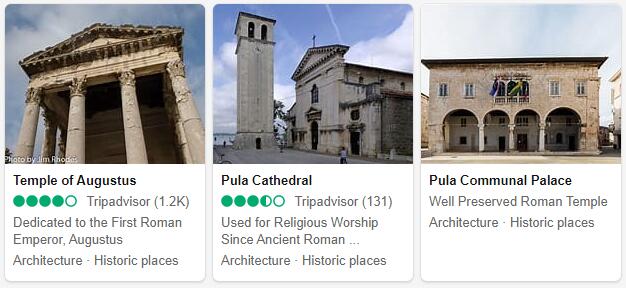
Attractions in Pula
In Pula, you can experience exciting architecture in the historic center, and see the clear influence of Asian architecture in the city’s triumphal arch. The streets themselves become attractions as you walk.
Anyway, here are some tips for something to take on your trip to Pula:
The Amphitheater, also known as Pula Arena, is the 6th largest surviving Roman amphitheater in the world. The theater was built at the same time as the Colosseum in Rome was built, that is in the middle of the first century.
The amphitheater accommodated 25,000 spectators when gladiatorial battles between humans and wild animals were on the menu. Fortunately, only the impressive edifice can be admired today, but the history can be relived in the building’s museum.
Today, a number of festivals and concerts are organized in the amphitheater, and is certainly an attraction to be seen.
You will find the Amphitheater in Istarska ulica, in the middle of the city.
Phone: +385 52 219 028
The Temple of Augustus another important servitude. Construction began before the birth of Christ and it was made in honor of the goddess of Rome and, as the name says, Emperor Augustus. The building houses an exhibition of beautiful bronze sculptures. You can experience the Temple of Augustus at the south end of Sergijevaca ulica.
St Mary’s Church is built on the site, the Christians gathered for secret prayer meetings in Roman times. The church has been rehabilitated on several occasions, but still retains much of its original elements. The floor mosaic in the chapel must be seen!
Tourist in Pula
Pula is becoming increasingly popular for hungry Scandinavians as a summer destination, and the city naturally has its many beaches along the Adriatic as its main attraction. Be aware that most of the beaches are rocky and may be most reminiscent of the archipelago in Norway.
It is probably only possible to find a sandy beach if you go to Bijeca Beach by Medulin. The most renowned beaches can be found in Verudela (where we have recommended several hotels), Premantura, Banjole and Fazana.
Pula has significant tourism associated with beach holidays with windsurfing and sailing. In addition, Pula has an old town which is well preserved. The town lies between seven mountains on the coast, with a well-protected harbor.
Near Pula it is not at all difficult to find a “deserted” beach if you want to be “alone”.
The tourist facilities are best on the outside of town. Just 4 kilometers from the city center you will find an area called Stoja. Buses take you regularly out and in from the city center. Here are all the sports facilities, hotels, campsites – and not least – beaches.
Along the beach there is a very beautiful promenade that you just have to stroll. The promenade goes from camping Stoja and Valkane Beach to Valsaline. Outside the center, e.g. at the Stoja area, there are many trees that seem pleasantly cool on hot summer days.
A famous gem near Pula is Brijuni National Park. Here you will see the remains of ancient Roman villages as well as enjoying the beauty of nature
Pula has a 3000 year history and was occupied by the Romans in 177 BC Even hundreds of years later, the peninsula of Istria and the city of Pula were largely populated by Italians. In the Middle Ages, it was Venice and Genoa that ruled Istria. The peninsula became Croatian after World War II. With this, many residents moved back to Italy, while the Croats took over houses and homes in Istria.
But although most Italians moved home, their culture, including food and drink, remained largely unchanged.
From Istria there are small ferries from different cities, including Pula, to Italy and not least Venice. The boat trip does not take many hours and is a nice get-away if the weather is good and you have enough time.
